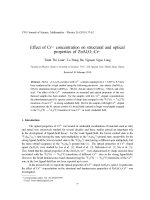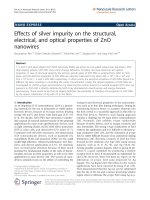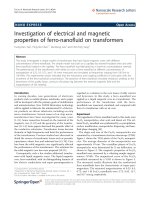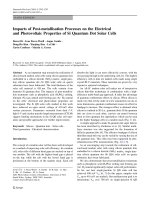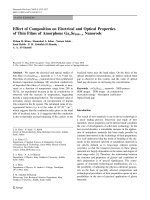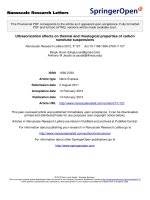Effects of silver incorporation on electrical and optical properties of CuAlxOy thin films
Bạn đang xem bản rút gọn của tài liệu. Xem và tải ngay bản đầy đủ của tài liệu tại đây (753.8 KB, 9 trang )
Hóa học – Sinh học – Mơi trường
Effects of silver incorporation on electrical
and optical properties of CuAlxOy thin films
Tran Ngoc Lan1*, Nguyen Tran Thuat2, Hoang Ngoc Lam Huong2, Nguyen Van Quynh1
1
University of Science and Technology of Hanoi, Vietnam Academy of Science and Technology;
Hanoi University of Science, Vietnam National University, Hanoi.
*
Corresponding author:
Received 30 Aug 2022; Revised 8 Nov 2022; Accepted 28 Nov 2022, Published 20 Dec 2022.
DOI: />2
ABSTRACT
The transparent conductive property based on Ag-doped delafossite nanomaterials are
attractive for optical sensing applications due to their good electrical conductivity, good optical
transparent and high temperature coefficient of resistance. Several delafossite nanomaterials
and Ag-doped nanomaterials have been reported, however, Ag-doped delafossite nanomaterials
have not been explored, especially regarding the electrical property with high temperature
coefficient of resistance. In this study, Ag-doped delafossite CuAlxOy thin films were deposited by
co-sputtering techniques. The electrical properties were carried out on a 4-point prober. The
optical properties were characterized on an UV-VIS spectrometer. The results on CuAlxOy doped
Ag thin films showed that CuAlxOy doped Ag can be hardly applied for transparent conductive
layers. However, these films exhibited relatively high temperature coefficient of resistance of
about 3%/K, thus being suitable for applications in microbolometers.
Keywords: Transparent conductive; Delafossite; CuAlxOy thin film; Co-sputtering techniques; Temperature
coefficient of resistance; Microbolometers.
1. INTRODUCTION
+
3+
Many delafossites (A B O2) were found on physical properties. They were reported at the first
time as part of large research about structure, synthesis, and electrical transport properties by
Rogers, Shannon, and Prewitt [1-3]. In a short time after, the optical and the electrical properties
of certain copper delafossites in a many papers were reported by Benko and Koffyberg [4, 5]. In
the 1997, the attention to delafossites decreased when a seminal paper by Kawazoe and coworkers found that a 500 nm thick film of CuAlO2 transmitted about 70% in visible light and
exhibited p-type conductivity of 0.95 S.cm-1 [6]. From then, delafossites, especially the Ag and Cu
elements, have received considerable attention owing to their application as the transparent
conducting oxides [7, 8]. Particular emphasis was placed on optimizing their electrical and optical
properties through proper selection of the parent delafossites, aliovalent dopant and control of the
oxygen stoichiometry. Because of their compositional versatility, delafossites also were studied
deeply as catalysts [2, 4, 5], luminescent materials [6, 7], and thermoelectrics [9-11].
Various methods for preparing delafossite oxides have been investigated such as hightemperature solid-state reactions, cation exchange reactions, hydrothermal reactions, for the
powders synthesis, and sputtering, sol−gel, pulsed laser deposition (PLD) for the preparation of
thin films. Since target material for thin film deposition is composed of particles, the synthesis of
phase-pure powder is the required initial step. Some general rules leading to the formation of
ABO2 oxides could be found in diverse synthesis methods. For example, copper-based
delafossite oxides (CuAlO2, CuCrO2, CuFeO2 and CuScO2) could be synthesized readily via high
temperature solid-state reactions under an inert atmosphere (N2 or Ar) at ∼ 800−1200 °C, since
Cu+ is even more stable than Cu2+ at high temperatures. However, for the low temperature
hydrothermal synthesis of CuAlO2, CuCrO2, and CuGaO2, the raised difficulty rests with how to
reduce the soluble Cu2+ precursor to Cu+ and maintain the valence of Cu+ in the monovalent state
294 T. N. Lan, …, N. V. Quynh, “Effects of silver incorporation … properties of CuAlxOy thin films.”
Nghiên cứu khoa học công nghệ
in a wet chemical environment. For the synthesis of silver-based delafossite oxides, solid-state
reactions at high temperature generally encountered practical problems, because of the easy
decomposition of Ag2O to elemental silver at a temperature of ∼300 °C. Therefore, most
reported silver-based delafossite oxides, such as AgInO2, AgCrO2, AgAlO2, and AgGaO2, were
synthesized via low-temperature hydrothermal methods in closed reaction systems. Moreover,
among the various delafossite oxides, CuAlO2 and AgAlO2 are more difficult to synthesize,
because of the higher crystal formation energy barrier, which is associated with cleavage and
reorganization of the high-energy Al−O bonds. Conversely, these two aluminum-based
delafossite oxides are superior in chemical and thermal stability than other delafossite oxides;
besides, high optical transparency and a low-cost aluminum source are two other important
advantages of these two materials, which are highly desired in many practical applications.
Although the synthesis of CuAlO2 nanocrystals at 400°C via supercritical hydrothermal methods
has been reported since 2004 few reports have followed up such a procedure, which might be
hard to reproduce. Besides, until now, there have been few systematical studies focusing on the
hydrothermal synthesis mechanism of aluminum-based delafossite oxides [12].
2. PROBLEM
2.1. Theoretical foundations
Electronic structure calculations and analysis of the Kubelka–Munk absorption data reveal
that, similar to copper delafossites, silver delafossites have a disparity in energy between the
“forbidden” fundamental direct and indirect band gaps and optically measured band gap. While
their optically measured band gaps widen with an increase in the radius of the B-site cation, the
decreased fundamental band gaps for larger B-site cations result in some absorption of photons
in the visible light range for AgGaO2 and AgInO2, which reduces their optical transparency and
thereby colors these delafossites. When corresponding copper and silver delafossites with the
same B-site cation are compared, however, silver delafossites have larger band gaps and lower
visible light absorption, owing to a shift in the valence band states to lower energy upon
replacement of copper 3d states with silver 4d states. Thus, the electronic structure prediction is
general (i.e., any silver delafossite has a larger band gap than the corresponding copper
delafossite). Moreover, while silver delafossites have conductivities lower than those of
polycrystalline powders of copper delafossites, this study provides a starting point for the
difficult process of improving the conductivity of delafossites through extrinsic doping without
significantly compromising their optical properties [13].
Another important electrical property of these materials is temperature coefficient of
resistance (TCR). The most important property of microbolometers is its infrared sensitive layer
TCR. Vanadium oxide is the traditional materials for the sensing layer of microbolometers due to
the high value of TCR which is in the range of 2%/K to 3%/K [14]. However, single crystal
vanadium oxide, which has higher TCR value of around 4%/K, is rather difficult to achieve [15].
In this study, ternary oxide minerals (MIMIIIO2, also known as delafossite oxide materials), or in
particular, CuAlO2 and AgAlO2, are chosen to be studied as an infrared sensitive material. This
type of materials has shown some interesting properties such as thermoelectric effect or being
used as transparent conducting oxide. However, not much research has been done on the TCR of
this type of materials.
Copper aluminate (CuAlO2), which is stable at high temperatures up to 1,400 K and possessing
a good thermoelectric power, is expected to be another promising material for thermoelectric
devices. This type of materials has also gained much attention in the field of optoelectronic
applications due to the fact that the CuAlO2 has a direct band gap of 3.5 eV and is a transparent
conductor. CuAlO2 crystallizes in the rhombohedra, delafossite p-type structure (a = 2.85670 Å,
Tạp chí Nghiên cứu KH&CN quân sự, Số Đặc san Hội thảo Quốc gia FEE, 12 - 2022
295
Hóa học – Sinh học – Mơi trường
c = 16.9430 Å) and shows p-type semiconductivity [16]. Park et al. have investigated the
thermoelectric properties of CuAl1-xCaxO2 (0 ≤ x ≤ 0.2) and found that the substitution of Ca for
Al up to x = 0.1 increases both the electrical conductivity and the Seebeck coefficient [17]. Lately,
the effects of Mg or Fe substitution for Al in CuAlO2 were also reported. Among these studied
elements, the highest value of power factor (1.1 × 10-4 W/mK) was obtained for the
CuAl0.9Fe0.1O2 sample at 1,140 K [18, 19]. Moreover, the calculation of the electronic structure of
Ni or Zn doped CuAlO2 using a full potential linear augmented plane-wave method, reported by
Lalic et al., showed that Ni and Zn substituted for Cu-sites act as acceptor and donor impurities,
respectively [20]. As for delafossite p-type of materials, the effect of Ag substitution for Cu-sites
in CuRhO2 has been investigated [21]. However, to our knowledge, the effect of element
substitution for Cu-sites in CuAlxOy has not been reported to date.
This study focuses on the substitution of Ag to Cu-sites in CuAlxOy and systematically
investigate their effects on the high temperature thermoelectric properties of these compounds.
Ag-doped delafossite CuAlxOy thin films were deposited by co-sputtering techniques. The
electrical properties were carried out on a 4-point prober. The optical properties were
characterized on an UV-VIS spectrometer. The results on CuAlxOy doped Ag thin films showed
that CuAlxOy doped Ag can be hardly applied for transparent conductive layers, however, it is
potential for applications in microbolometers.
2.2. Experiment preparation
2.2.1. Instrumentation
In this study, Ag-doped CuAlxOy thin films were deposited on corning glass substrates by
using co-sputtering techniques. The corning glass substrates were cleaned by acetone and
isopropanol solution in ultrasonic vibration then were soaked in piranha solution, and discharge
with deionized water and nitrogen gun. All chemicals used are of high quality and purity from
Xilong Chemical Co., Ltd., China. Commercial 2-inch of diameter Cu, Ag and Al2O3 targets
which have a purity of about 99.95% from Changsha Xinkang Advanced Materials Co., Ltd.,
China was used. Two series of CuAlxOy thin films were fabricated by co-sputtering with: (i) the
Cu and the Al2O3 targets, (ii) the Cu, the Ag and the Al2O3 targets. All of the samples were
deposited on a Syskey SP-01 2-DC and 2-radio frequency (RF) magnetron gun system. The
Al2O3 target was loaded on the RF1 gun, the Cu target was loaded on the DC2 gun and the Ag
target was loaded on the RF2 gun. The distance between guns and substrates was fixed at 9cm.
The oil pump and the turbo pump were used to reduce the pressure in the chamber to below
5x10-6 Torr. Argon (Ar) air and Oxygen (O2) were used together for sputtering: Ar was set = 16
sccm, O2 was set = 4 sccm. Pressure in the chamber was set = 7.5x10 -3 Torr. The thicknesses of
the films were characterized on an alpha-step model NanoMap-500LS. The optical properties of
all the thin films were characterized on an ultra violet visible (UV-VIS) spectrophotometer,
Shimadzu UV-2450. The sheet resistance of thin films was measured on a four-point prober,
Jandel RM3000. The measurement and the control temperature system, which are Self-designed
by us, are combined with the 4-point probe Jandel RM3000 and the emitter current source
Keithley 2400.
2.2.2. Experimental materials
From the list of CuAlxOy samples shows on the table 1 below, these samples were cosputtered by aluminum oxide target, copper target and silver target. However, silver was
sputtered in some seconds, while copper and aluminum oxide were sputtered in 1 hour. We kept
the sputtering temperature at 200 °C, sputtering power of Al2O3 at 40 W, sputtering power of Cu
varying from 20 W to 80 W and sputtering power of Ag at 20 W.
296 T. N. Lan, …, N. V. Quynh, “Effects of silver incorporation … properties of CuAlxOy thin films.”
Nghiên cứu khoa học công nghệ
Table 1. The list of CuAlxOy samples.
Number of sample
1 2 3 4 5 6 7 8 9 10 11 12 13 14
Sputtering power of Cu (W) 20 40 60 80
60
80
Ag-20W sputtering time (s)
0
5 10 15 30 60 5 10 15 30 60
3. RESULTS AND DISCUSSION
3.1. Thickness of thin films
Figure 1a. The thickness of CuAlxOy thin
Figure 1b. The thickness of CuAlxOy thin films
films depended on sputtering power of Cu.
depended on Ag sputtering time.
Fig. 1a shows clearly that the thickness of CuAlxOy sample increased as the sputtering power
of copper increased. The thickness rose quite linearly from 227 nm to 778 nm corresponding to
sputtering power of copper increased from 20 W to 80 W.
Fig. 1b illustrates that the thickness of CuAlxOy samples depended on the silver sputtering
time. It had significant errors, however, the trend of thickness of samples increased as silver
sputtering time increased.
The thickness of all samples was suitable to study the optical and electrical properties of nano
thin films but is not the main criterion for selecting the sample fabrication conditions.
3.2. Optical properties
From the Fig. 2a, we can easily to see that the transmission of CuAlxOy thin films decreased
as the sputtering power of copper increased. Especially, the transmission between Cu-20W
sample and Cu-40W sample was very different; however, the transmission between Cu-40W and
Cu-80W sample was not much different. Besides, the transmission of Cu-20W sample at 550 nm
wavelength was higher than 10%, however, the transmissions of others were nearly down to 0%.
Fig. 2b illustrates the transmission of series Cu-60W-Al2O3-40W-Ag-20W with the silver
sputtering time increased steadily. When the silver was doped in 5 s the transmission of sample
increased significantly. Up to 10 s, the transmission was higher than 5 s sample at longer than 800 nm
wavelength but lower than 5 s sample in visible range. Up to 15 s, 30 s and 60 s, the transmissions of
these samples were continuous reduction in all wavelengths from 300 nm to 900 nm.
From the Fig. 2c, the transmission on series of Cu-80W-Al2O3-40W-Ag-20W with the change
of silver sputtering time was examined. There were 2 parts of wavelength to be evaluated here.
In visible range, the transmission of 0s-Ag sample was the lowest and 5s-Ag sample was the
highest then decreased steadily by silver sputtering time. In contrary, at the longer wavelength,
especially higher than 850 nm, the transmissions of 5s-Ag and 10s-Ag samples were lowest and
the transmission of 60s-Ag sample was highest.
The average transmittance of all CuAlxOy samples in visible range and easily found that 2
important features. The transmission decreased strongly as the sputtering power of copper
Tạp chí Nghiên cứu KH&CN quân sự, Số Đặc san Hội thảo Quốc gia FEE, 12 - 2022
297
Hóa học – Sinh học – Mơi trường
increased. Besides, the decreasing of transparent also depended on the increasing of silver
sputtering time.
Figure 2a. Effect of sputtering power of copper to the transparent of CuAlxOy thin films.
Figure 2b. Effect of silver sputtering time to
the transparent of CuAlxOy-Cu 60W thin films.
Figure 2c. Effect of silver sputtering time to
the transparent of CuAlxOy-Cu 80W thin films.
3.3. Electrical properties
Fig. 3a shows the resistance depended on temperature of 4 series of CuAlxOy thin films. On
this figure, we could confirm that these samples had negative thermal coefficient of resistance as
semiconductor. Besides, the resistance of Cu-60W sample was highest and the resistance of Cu20W sample was lowest.
Fig. 3b gives us the results of resistance depend on temperature by increasing the silver
sputtering time of series of Cu-60W samples. From this figure, we could find that the highest
resistance on the 15s Ag sample and the lowest resistance on the 30s Ag sample.
Figure 3a. The resistance depended on temperature of CuAlxOy thin films.
298 T. N. Lan, …, N. V. Quynh, “Effects of silver incorporation … properties of CuAlxOy thin films.”
Nghiên cứu khoa học công nghệ
Figure 3b. The resistance depended on
Figure 3c. The resistance depended on
temperature of Ag doped CuAlxOy-Cu
temperature of Ag doped CuAlxOy-Cu
60W thin films.
80W thin films.
Fig. 3c shows the resistance depends on temperature of series of silver doped CuAlxOy-Cu 80 W
thin films. There is quite clear that the resistor increased strongly when the silver sputtering time
increased more than 15 s. The highest resistance was observed on 30s Ag sample.
Figure 4a. The TCR and the conductivity of CuAlxOy thin films depended on
sputtering power of copper.
Figure 4b. The TCR and the conductivity of
CuAlxOy-Cu 60W thin films
depended on silver sputtering time.
Figure 4c. The TCR and the conductivity of
CuAlxOy-Cu 80W thin films
depended on silver sputtering time.
The most important of our concern on CuAlxOy thin films were TCR and resistivity. We
would like to get the sample, which had the highest TCR but its resistivity was not too high as
Tạp chí Nghiên cứu KH&CN quân sự, Số Đặc san Hội thảo Quốc gia FEE, 12 - 2022
299
Hóa học – Sinh học – Mơi trường
good conductivity. From the Fig. 4a, we can easily to find out that the TCR of Cu-60W sample
and the TCR of Cu-80W sample were highest as more than 2.5%. These results were as good as
the best TCR of Vanadium pentoxide material, which was the most popular material, be used for
microbolometers, which was 2.57% [22]. Therefore, on the next step, we would like to study the
effect of silver on these two samples.
Fig. 4b indicates the TCR and the resistivity of series of Cu-60W samples. There was a little
contradiction here. The samples, which had high TCR, also had high resistivity. In contrary, the
samples, which was good conductivity as had low resistivity, also had lower TCR. However, we
could confirm that doping silver into CuAlxOy thin films was suitable for increasing TCR or
reducing resistivity of them.
Fig. 4c also illustrates the contrast between TCR and the resistivity of CuAlxOy-Cu 80W thin
films. However, the biggest success, which we found here, was the highest TCR of 30s Ag
sample as more than 3%. There was clearly better than CuAlxOy sample without silver. On the
other hand, doping Ag by sputtering in 10s gave a little lower TCR, however, increasing
conductivity significantly as reducing resistivity of sample. The highest TCR, which was
obtained, is not the highest TCR has been found in the world. There were higher TCR materials
has been found in Metal-oxide manganite (4.4%/°K), GexSi1-xOy (5.1%/°K) [23], or silicon thin
films (6%/°K) [24, 25], etc. However, these materials have some huge disadvantages that very
high large 1/f noise or manufacturing conditions are complex and expensive. Therefore, CuAl xOy
and CuAlxOy doping Ag are really valuable materials that can be applied well in
microbolometers.
In order to explain why we can get higher TCR materials by doping silver, we assume that
silver with a suitable amount doping in materials can help to narrow the energy band gap to
increase conductivity. Materials, which have high TCR, need to have high band gap but not to
have too high band gap. Ideal materials, which have high TCR, need both abilities to conduct and
non-conduct and temperature can help to change that property. Therefore, because CuAlxOy has
high band gap (~3.48eV), we need a little amount silver to dope in order to improve the
conductivity at high temperature. Besides, at low temperature, with a little amount of silver, the
non-conductive property still remains high and is not affected. However, if amount of silver
doping was too high, the high conductive could be seen also at low temperature and TCR value
could be not high.
4. CONCLUSION
In this study, a co-sputtered process for fabricating transparent conductive oxides CuAlxOy
thin films was developed. When doping 30s Ag in to the CuAlxOy sample corresponding to the
sputtering power of Cu target of 80 W, power of Al2O3 target of 40 W, power of Ag of 20 W, the
thermal coefficient of resistance of thin films was higher than 3%. The higher the thermal
coefficient of resistance, the better the sensitivity of the infrared sensor layer. Therefore, we
could confirm that silver incorporation on CuAlxOy thin films may be used for applications as an
infrared sensing layer in microbolometers.
REFERENCES
[1]. R. D. Shannon, C. T. Prewitt, and D. B. Rogers, “Chemistry of noble metal oxides. II. Crystal
structures of platinum cobalt dioxide, palladium cobalt dioxide, coppper iron dioxide, and silver iron
dioxide,” Inorg. Chem., vol. 10, no. 4, pp. 719–723, (1971), doi: 10.1021/ic50098a012.
[2]. R. D. Shannon, D. B. Rogers, C. T. Prewitt, and J. L. Gillson, “Chemistry of noble metal oxides. III.
Electrical transport properties and crystal chemistry of ABO2 compounds with the delafossite
structure,” Inorg. Chem., vol. 10, no. 4, pp. 723–727, (1971), doi: 10.1021/ic50098a013.
[3]. R. D. Shannon, D. B. Rogers, and C. T. Prewitt, “Chemistry of noble metal oxides. I. Syntheses and
300 T. N. Lan, …, N. V. Quynh, “Effects of silver incorporation … properties of CuAlxOy thin films.”
Nghiên cứu khoa học công nghệ
properties of ABO2 delafossite compounds,” Inorg. Chem., vol. 10, no. 4, pp. 713–718, (1971), doi:
10.1021/ic50098a011.
[4]. F. A. Benko and F. P. Koffyberg, “Opto-electronic properties of p- and n-type delafossite, CuFeO2,”
J. Phys. Chem. Solids, vol. 48, no. 5, pp. 431–434, (1987), doi: 10.1016/0022-3697(87)90103-X.
[5]. F. A. Benko and F. P. Koffyberg, “Opto-electronic properties of CuAlO2,” J. Phys. Chem. Solids,
vol. 45, no. 1, pp. 57–59, (1984), doi: 10.1016/0022-3697(84)90101-X.
[6]. H. Kawazoe, M. Yasukawa, H. Hyodo, M. Kurita, H. Yanagi, and H. Hosono, “P-type electrical
conduction in transparent thin films of CuAlO2,” Nature, vol. 389, no. 6654, pp. 939–942, (1997),
doi: 10.1038/40087.
[7]. D. S. Ginley and C. Bright, “Transparent Conducting Oxides,” MRS Bull., vol. 25, no. 08, pp. 15–
18, (2000), doi: 10.1557/mrs2000.256.
[8]. H. Kawazoe, H. Yanagi, K. Ueda, and H. Hosono, “Transparent p-Type Conducting Oxides: Design
and Fabrication of p-n Heterojunctions,” MRS Bull., vol. 25, no. 08, pp. 28–36, (2000), doi:
10.1557/mrs2000.148.
[9]. J. MONNIER, “A study of the catalytically active copper species in the synthesis of methanol over
Cu$z.sbnd;Cr oxide,” J. Catal., vol. 92, no. 1, pp. 119–126, (1985), doi: 10.1016/0021-9517(85)90241-6.
[10]. J. Christopher and C. S. Swamy, “Catalytic activity and XPS investigation of dalofossite oxides,
CuMO2 (M=Al, Cr or Fe),” J. Mater. Sci., vol. 27, no. 5, pp. 1353–1356, (1992), doi:
10.1007/BF01142052.
[11]. K. Domen, S. Ikeda, T. Takata, A. Tanaka, M. Hara, and J. N. Kondo, “Mechano-catalytic overall
water-splitting into hydrogen and oxygen on some metal oxides,” Appl. Energy, vol. 67, no. 1–2, pp.
159–179, (2000), doi: 10.1016/S0306-2619(00)00012-X.
[12]. D. Xiong et al., “Synthesis and characterization of CuAlO2 and AgAlO2 delafossite oxides through
low-temperature hydrothermal methods,” Inorg. Chem., (2014), doi: 10.1021/ic500090g.
[13]. H. Dong et al., “Visible light-induced photocatalytic activity of delafossite AgMO2 (M=Al, Ga, In)
prepared via a hydrothermal method,” Appl. Catal. B Environ., vol. 89, no. 3–4, pp. 551–556,
(2009), doi: 10.1016/j.apcatb.2009.01.018.
[14]. O. Celik and M. Duman, “High temperature coefficient of resistance and low noise tungsten oxide
doped amorphous vanadium oxide thin films for microbolometer applications,” Thin Solid Films, vol.
691, p. 137590, (2019), doi: 10.1016/j.tsf.2019.137590.
[15]. R. Mustafa ệksỹzolu, P. Bilgiỗ, M. Yldrm, and O. Deniz, “Influence of post-annealing on
electrical, structural and optical properties of vanadium oxide thin films,” Opt. Laser Technol., vol.
48, pp. 102109, (2013), doi: 10.1016/j.optlastec.2012.10.001.
[16]. R. Mustafa ệksỹzolu, P. Bilgiỗ, M. Yildirim, and O. Deniz, “Influence of post-annealing on
electrical, structural and optical properties of vanadium oxide thin films,” Opt. Laser Technol., vol.
48, pp. 102–109, (2013), doi: 10.1016/j.optlastec.2012.10.001.
[17]. K. Park, K. Y. Ko, and W. S. Seo, “Effect of partial substitution of Ca for Al on the microstructure
and high-temperature thermoelectric properties of CuAlO2,” Mater. Sci. Eng. B Solid-State Mater.
Adv. Technol., vol. 129, no. 1–3, pp. 1–7, (2006), doi: 10.1016/j.mseb.2005.10.035.
[18]. K. Park, K. Y. Ko, J. K. Seong, and S. Nahm, “Microstructure and high-temperature thermoelectric
properties of polycrystalline CuAl1-xMgxO2 ceramics,” J. Eur. Ceram. Soc., vol. 27, no. 13–15, pp.
3735–3738, (2007), doi: 10.1016/j.jeurceramsoc.2007.02.030.
[19]. K. Park, K. Y. Ko, H.-C. Kwon, and S. Nahm, “Improvement in thermoelectric properties of CuAlO2
by adding Fe2O3,” J. Alloys Compd., vol. 437, no. 1–2, pp. 1–6, (2007), doi:
10.1016/j.jallcom.2006.07.067.
[20]. S. Yanagiya, N. Van Nong, J. Xu, and N. Pryds, “The Effect of (Ag, Ni, Zn)-Addition on the
Thermoelectric Properties of Copper Aluminate,” Materials (Basel)., vol. 3, no. 1, pp. 318–328,
(2010), doi: 10.3390/ma3010318.
[21]. J. Gu et al., “p -Type CuRhO 2 as a Self-Healing Photoelectrode for Water Reduction under Visible
Light,” J. Am. Chem. Soc., vol. 136, no. 3, pp. 830–833, (2014), doi: 10.1021/ja408876k.
[22]. M. Abdel-Rahman et al., “Temperature coefficient of resistance and thermal conductivity of
Vanadium oxide ‘Big Mac’ sandwich structure,” Infrared Phys. Technol., vol. 71, pp. 127–130,
(2015), doi: 10.1016/j.infrared.2015.03.006.
[23]. F. Niklaus, C. Vieider, and H. Jakobsen, “MEMS-based uncooled infrared bolometer arrays: a
Tạp chí Nghiên cứu KH&CN quân sự, Số Đặc san Hội thảo Quốc gia FEE, 12 - 2022
301
Hóa học – Sinh học – Mơi trường
review,” (2007), vol. 6836, p. 68360D, doi: 10.1117/12.755128.
[24]. P. Sharma, X. Sun, G. Parish, and A. Keating, “Optimising porous silicon electrical properties for
thermal sensing applications,” Microporous Mesoporous Mater., vol. 312, p. 110767, (2021), doi:
10.1016/j.micromeso.2020.110767.
[25]. P. Sharma, J. Dell, G. Parish, and A. Keating, “Engineering 1/f noise in porous silicon thin films for
thermal sensing applications,” Microporous Mesoporous Mater., vol. 324, p. 111302, (2021), doi:
10.1016/j.micromeso.2021.111302.
TÓM TẮT
Ảnh hưởng của bạc pha tạp tới các tính chất quang và điện của các màng mỏng CuAlxOy
Tính chất dẫn điện truyền qua dựa trên vật liệu nano delafossite pha tạp Ag rất quan
trọng đối với các ứng dụng cảm biến quang học do tính chất dẫn điện tốt, độ truyền qua
quang học tốt và hệ số nhiệt điện trở cao. Một số vật liệu nano delafossite và vật liệu nano
pha tạp Ag đã được báo cáo, tuy nhiên, vật liệu nano delafossite pha tạp Ag vẫn chưa
được khám phá, đặc biệt là về tính chất điện với hệ số nhiệt điện trở cao. Trong nghiên
cứu này, màng mỏng delafossite CuAlxOy pha tạp Ag được lắng đọng bằng phương pháp
đồng phún xạ. Các tính chất điện được đo bằng máy đo điện trở 4 điểm. Các tính chất
quang học được đo trên máy quang phổ UV-VIS. Kết quả nghiên cứu cho thấy CuAlxOy
pha tạp Ag khó có thể ứng dụng cho các lớp dẫn điện trong suốt. Tuy nhiên, các màng
mỏng này cho thấy hệ số nhiệt điện trở tốt với giá trị tương đối cao, khoảng 3%/ºK, do đó
vật liệu thích hợp cho các ứng dụng cho microbolometers.
Từ khố: Dẫn điện truyền qua; Delafossite; Màng mỏng CuAlxOy; Phương pháp đồng phún xạ; Hệ số nhiệt điện trở;
Microbolometers.
302 T. N. Lan, …, N. V. Quynh, “Effects of silver incorporation … properties of CuAlxOy thin films.”

